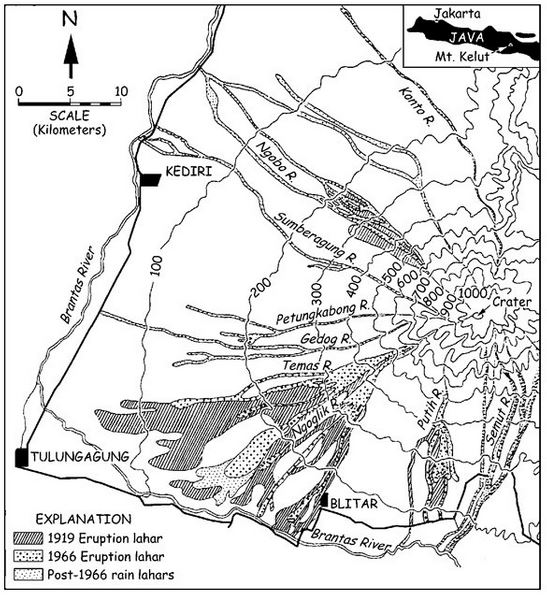17 March 2020
The catastrophic lahars from Mount Kelud in 1919
Posted by Dave Petley
The catastrophic lahars from Mount Kelud in 1919
On 19 and 20 May 1919 a catastrophic eruption occurred on Mount Kelud in East Java, Indonesia. This major eruption, one of the most deadly of the 20th Century, is estimated to have killed 5,160 people. The vast majority of those died in lahars (volcanic debris flows) triggered by the eruption. This was also one of the worst landslide disasters of the 20th Century.
There is a really interesting paper about the social impact of this event (Mawiyato and Sasmita 2019) available online, open access. They point out that this is a particularly interesting lahar event in part because of the detailed accounts of the impacts. The underlying problem at Mount Kelud is the presence of a crater lake, which at the time had an estimated volume of 40 million cubic metres. The eruption displaced this lake, which entrained large volumes of ash, generating the enormous lahars. On Researchgate there is a map of the deposits left by these landslides:

The lahars generated by the Mount Kelud eruption in 1919. Image posted to Researchgate by Kelvin Rodolfo, modified from an unpublished monograph of the Japan International Cooperation Agency
.
Mawiyato and Sasmita (20189) provide an account of the lahars, with a focus on those that travelled southwards to Blitar:
Bladak Dam of Kali Lahar, which was built to reduce the lahar floods of Mount Kelud, was destroyed. With a speed of 60 km/h, the flows of lahar reached Blitar in less than an hour and destroyed everything standing in its way. The scale of damage reached dozens of kilometers of the volcano. Many villages were reported to have been flattened to the ground and even some of them were wipe out from the map. Among the destroyed vilages were Sumbersari, Salam, Ngoran villages in Udanawu district. Villages along the road stretching from Panataran Temple to Blitar were badly devastated and also Omboh, Sidareja and Sumberejo villages of Wlingi.
To illustrate the magnitude of the impact of these lahars, Mawiyato and Sasmita (2019) describe the events in a prison located in the path of the lahars. About 900 prisoners were trapped in their cells. Of these only about 100 were able to escape the lahar, but they were quickly caught by the flows and were killed. There is perhaps no worse prospect than that of being trapped in a locked cell as it fills with boiling mud.
The devastation of the lahars are also well described. For example, this is the account of the damage in the town of Blitar:
Instantly Blitar lost its form as a town, turned into a sea of lahar. It was dark as being covered by cloud resulting from the swift ash rain. The height of the lahar was approximately 1.6 m, houses around the town square were all damaged, many walled houses were collapsed. The Chinese, Dutch, Javanese settlements whose house-buildings between were somewhat distant could be said to be non-existent. Only the houses of brick walls that coincided and hand-in-hand were not so damaged, but the walls were broken down, such as the house of the resident master, the district house, the post office, the bank office, the clinic, the hotel, the detention center and the other.
Apart from the loss of life, the lahars and ashfall caused massive damage to the extensive coffee farms on the flanks of the volcano, and to other agricultural areas.
Mount Kelud erupted again in 1966, killing more than 200 people. To manage the hazard, a set of tunnels, known as the Ampera Tunnels, were constructed to manage the water levels in the crater.
Reference
Nawiyanto and Sasmita, N. 2019. The Eruption of Mount Kelud in 1919: Its Impact and Mitigation Efforts. In: 1st International Conference on Social Sciences and Interdisciplinary Studies (ICSSIS 2018). Atlantis Press. https://doi.org/10.2991/icssis-18.2019.25.


 Dave Petley is the Vice-Chancellor of the University of Hull in the United Kingdom. His blog provides commentary and analysis of landslide events occurring worldwide, including the landslides themselves, latest research, and conferences and meetings.
Dave Petley is the Vice-Chancellor of the University of Hull in the United Kingdom. His blog provides commentary and analysis of landslide events occurring worldwide, including the landslides themselves, latest research, and conferences and meetings.
This is good info, but was there a specific time it erupted? Was it in the morning? The evening? Midday? Not being rude I just wanted to know if anyone knew
what was the tempeture